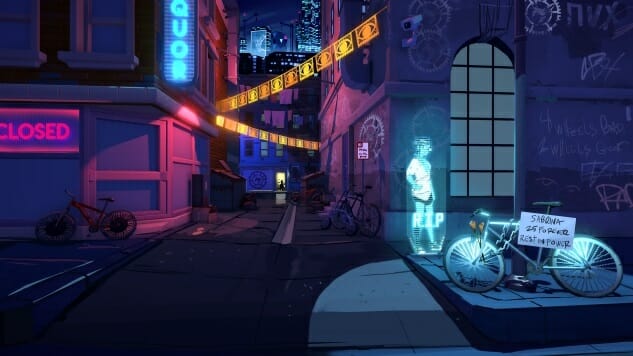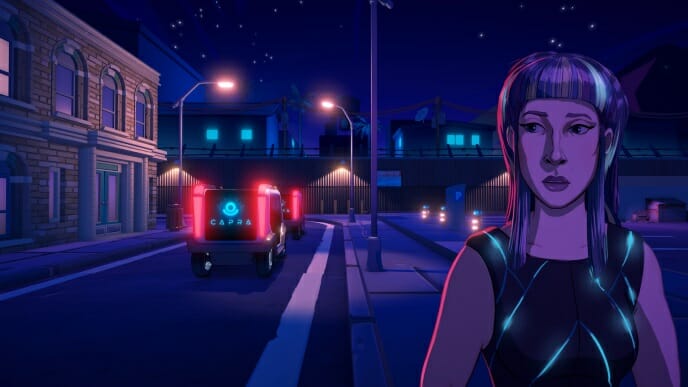On the Lonely, Gentrified Streets of Neo Cab

Beneath the veneer of its cerulean and purple glow, the city Los Ojos is a monotonous place. Its clinical uniformity is the backdrop against which Lena, the protagonist of Neo Cab, lives her life. There are no crowds on the sidewalks of Los Ojos. No distinct signages mark the location of restaurants or stores. Homes and hotels are replaced with sleep pods and Airbnb, and most nights, Lena spends her time hustling just enough cash to have a place to sleep. The monotony of her routine is mirrored in her surroundings; every one of the streets she drives is just like the next. For all its bustle and thriving nightlife, Los Ojos may as well be a ghost town. There are few distinguishing features in the parallax scrolling of her life.
In terms of how the game was designed, the cold repetition of Neo Cab’s streets (illustrated adeptly by art director Vincent Perea) was likely as much a practical decision as it was a creative one. Many forms of animation feature a repeating background. Not only does it allow writers to tell a story without getting bogged down by details that aren’t necessary to the plot, it also avoids drawing attention to irrelevant details. It’s also a handy way to demonstrate the impersonal feel of a city, while also saving money and time.
But what it reflects, whether deliberate or accidental, is an inhospitality seen in what writer Charles Mudede recently called “second-wave gentrification”. The term, building on the work of urban sociologist Ruth Glass, was also recently used by Stanford professor Adrian Daub to describe the shifting economy in San Francisco and explain how prosperity has actually changed the community for the worse.
Whereas first-wave gentrification displaces small businesses and middle to lower class residents as the neighborhood gains real estate value, eroding the institutions that make lower class life bearable, second-wave gentrification goes further: after it drains a community by raising the rent, it lets empty buildings sit, waiting for the day the market will “bounce back” to get a return on their investment, even as all signs of habitation ebb away. What first-wave starts, second-wave finishes, turning a metropolis into a rich man’s playground, where amenities like grocery stores and laundromats are replaced by hired help and Amazon Prime Now. It consumes only what others have built, and discards an empty husk.

Mudede’s nod to the concept was in criticism of the growing exodus of retail in Seattle (at this point a modern Deir el-Medina to Amazon), but the juxtaposition against Neo Cab’s comment on the gig economy is apt. While Daub was inspired to use the term “second-wave gentrification” in reference to San Francisco (a city that likely informed the design of Neo Cab), there are parallels in the emptiness of Los Ojos and Amazon’s effect on Seattle, in the rising rents, the vanishing businesses, and the slow collapse of our restaurant and bar scene. The city has always had a problem with gentrification and neoliberalism but in the past four years it has accelerated with a viciousness.
I see a parallel also in Lena’s loneliness. Her gig economy job, dependent on the user feedback ratings on the cab company’s app, is the literal manifestation of the concept of alienation of labor. Her economic interactions masquerade as social ones, and despite the artificiality of the pressure on her to be likeable, she’s all but alone. Despite all the modern conveniences of communication, she cannot manage to connect with the one person she even knows in Los Ojos, supplementing her need for companionship by settling for the brief warmth of interacting with her repeat customers. At the end of the day, Lena could easily be replaced by any other driver, or perhaps one of the robot drivers at the competing cab company, and no one would even notice. Like the streets she drives every night, the appearance of community and habitation is just an illusion.
I think back to Mudede’s proclamation that second-wave gentrification is its terminal stage, and wonder if I’m naive to hope he’s wrong. Looming in the shadow of Amazon and big tech, it’s hard to say if Seattle will ever adopt the necessary measures to reverse the course of mass exodus, like rent control, and socialized health care. San Francisco doesn’t look much better. But I can’t help but think that where human beings can survive, the uniqueness we attribute to our surroundings will still be found in the memories we ascribe to them through the bonds we share with other people.
And with that, the inspiration to organize and push back against the sterilization of our culture will endure too.
Holly Green is the assistant editor of Paste Games and a reporter and semiprofessional photographer. She is also the author of Fry Scores: An Unofficial Guide To Video Game Grub. You can find her work at Gamasutra, Polygon, Unwinnable, and other videogame news publications.